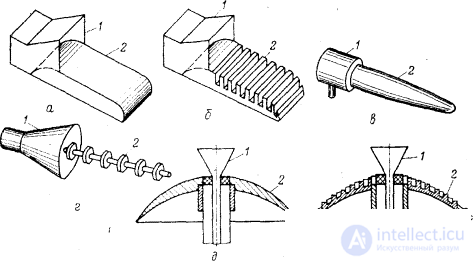An antenna of surface waves consists of a pathogen and a guide (Fig.14.1). The causative agent is designed so that it transfers as much of the energy as possible from the generator to the guide, the wave propagating along the guide is a surface wave. The radiating element of the antenna is basically a guide. Direct emission of the pathogen is usually weakly directed and therefore forms the side lobes of the DN. In addition, it interferes with the radiation of the guide and distorts the main lobe.
The guide is a segment of the surface wave transmission line. As is known, the phase velocity of such a wave is less than the speed of light. For the formation of a surface wave as a guide, slow structures are used.
Usually the guide is either dielectric (Figure 14.1, a , b, d), or metallic ribbed (Figure 14.1, 6, g , e).
According to the shape of the antenna, the surface wave antenna is subdivided into flat linear waves (Fig.14.1, a, b), rod waves (Fig.14.1, c, d) and disk (Fig.14.1, d, e). For linear and disk antennas, the retarding structure is usually placed on the screen - a metal substrate. The most widely used antennas are shown in Fig.14.1, c, d. The first is called a dielectric rod antenna, and the second is a ribbed-rod antenna.

Fig. 14.1. Types of surface wave antennas: 1 - pathogen; 2 - a guide.
To match the antenna with free space, the thickness of the guide to its end is reduced, whereby the phase velocity of the surface wave at the end of the guide approaches the speed of light and the reflected wave is eliminated. Thus, a traveling wave propagates along the guide. This allows us to consider the surface wave antenna as a type of axial (longitudinal) radiation antennas. For such antennas, as is known (see §3.4), the main lobe of the DN is oriented along the direction of the wave (in this case from the pathogen to the end of the guide).
On the other hand, the surface wave antenna can be attributed to aperture antennas, considering the surface of the guide as the aperture. Therefore, if we determine the tangential components of the electric and magnetic fields on the surface of the guide and consider each element of the surface as an elementary radiator, then, using the aperture method described in Ch. 4, it is possible to determine the radiation field of the surface wave antenna.
As exciters of flat linear and rod antennas, one-sidedly directed radiators are used: a horn, a vibrator with a reflector, a grid of slots, the open end of a waveguide. The driver of the disk antenna must not be directed in the plane of the disk. Typically, an asymmetrical vibrator is used for this purpose.


Comments
To leave a comment
Microwave Devices and Antennas
Terms: Microwave Devices and Antennas